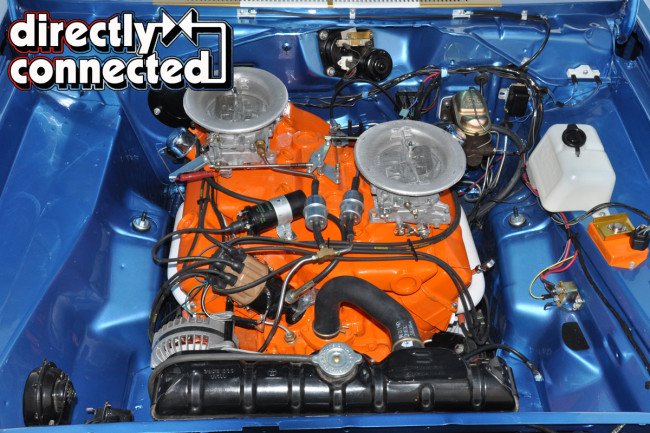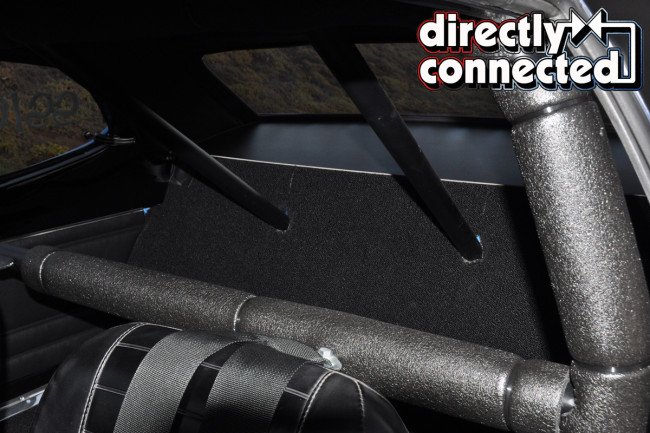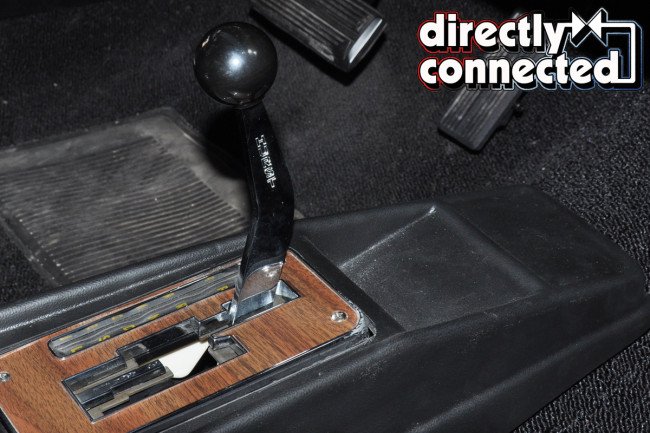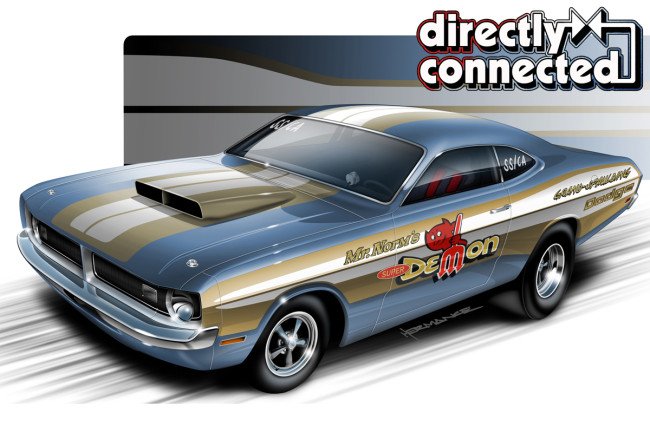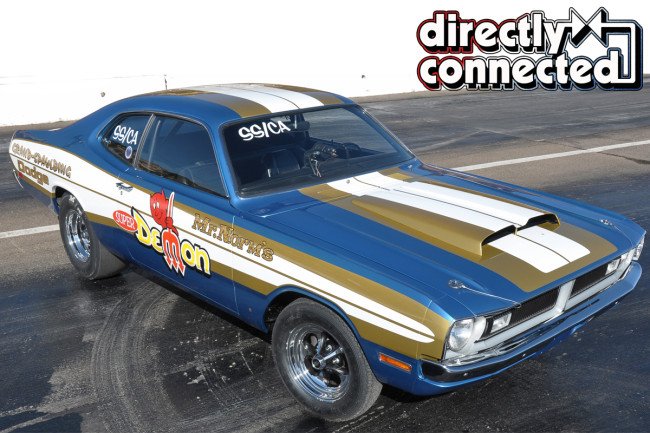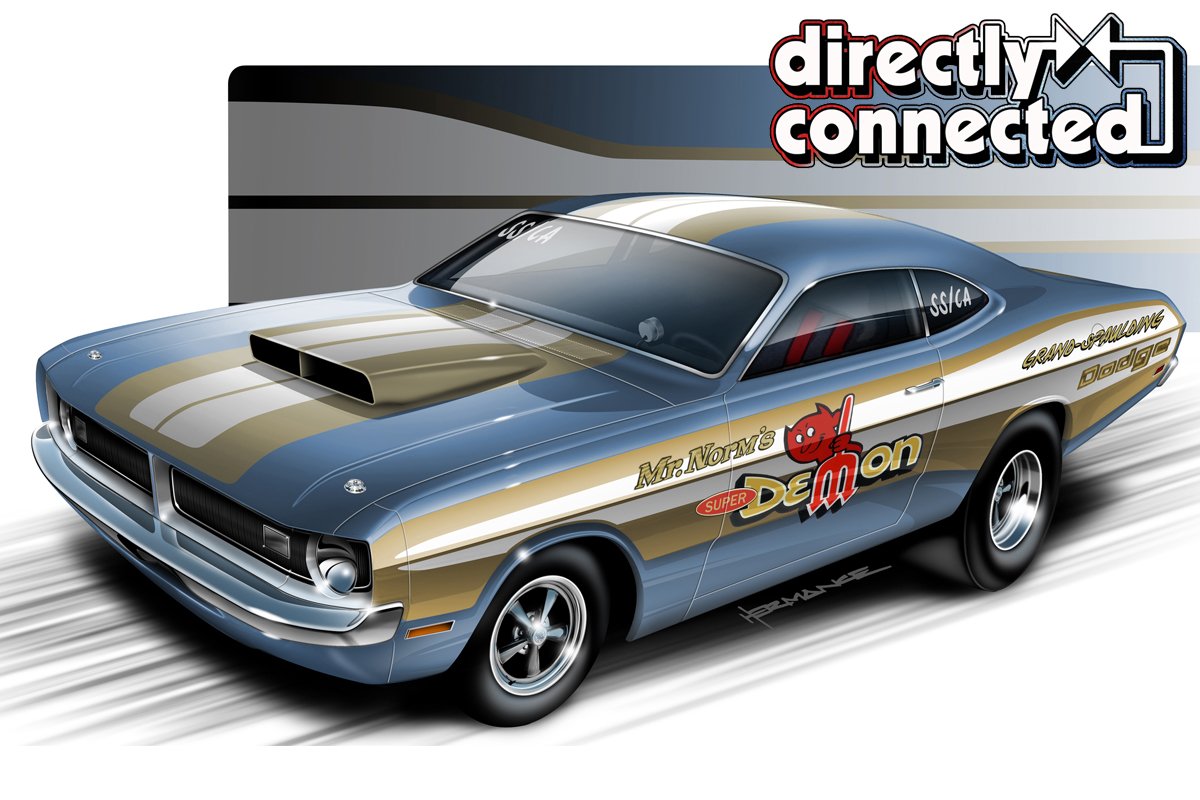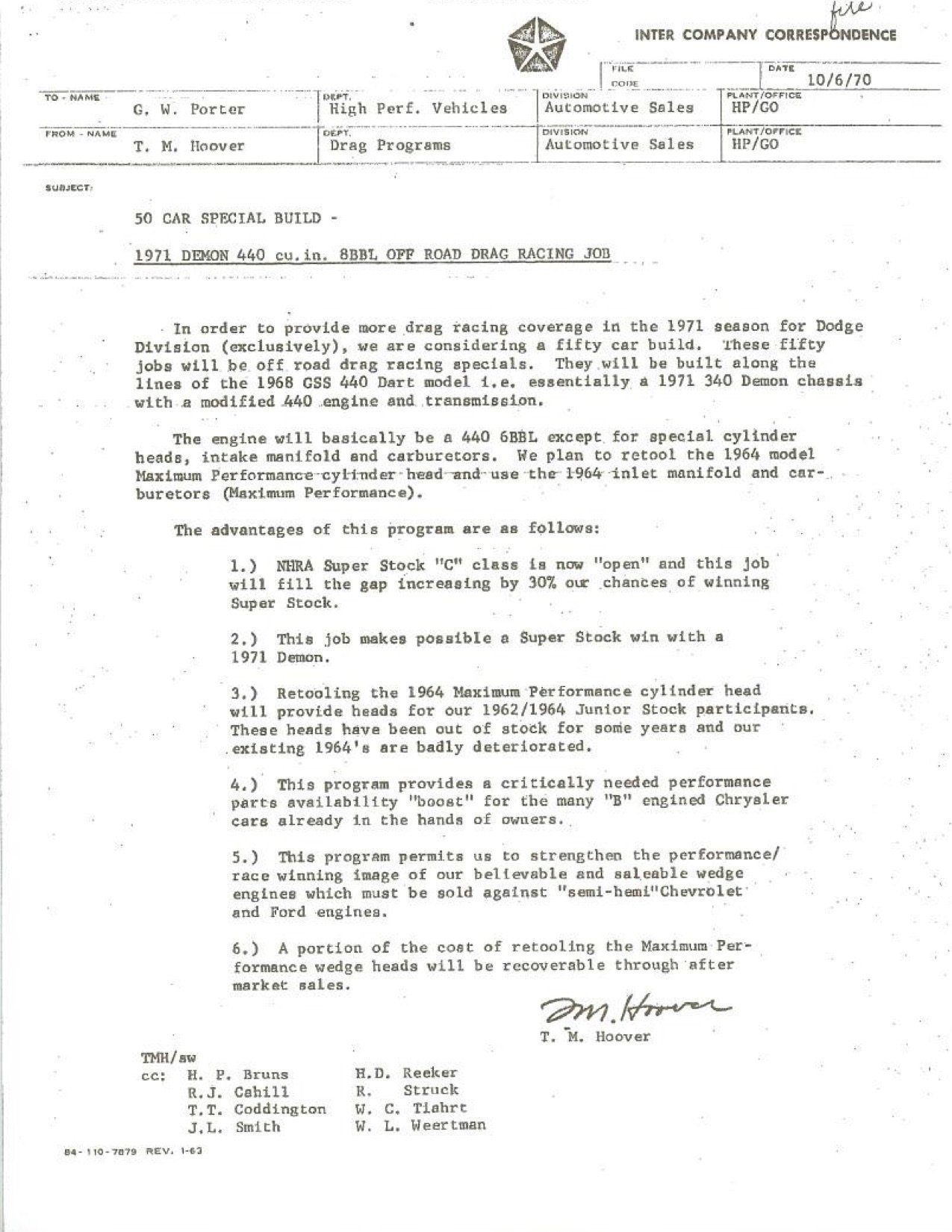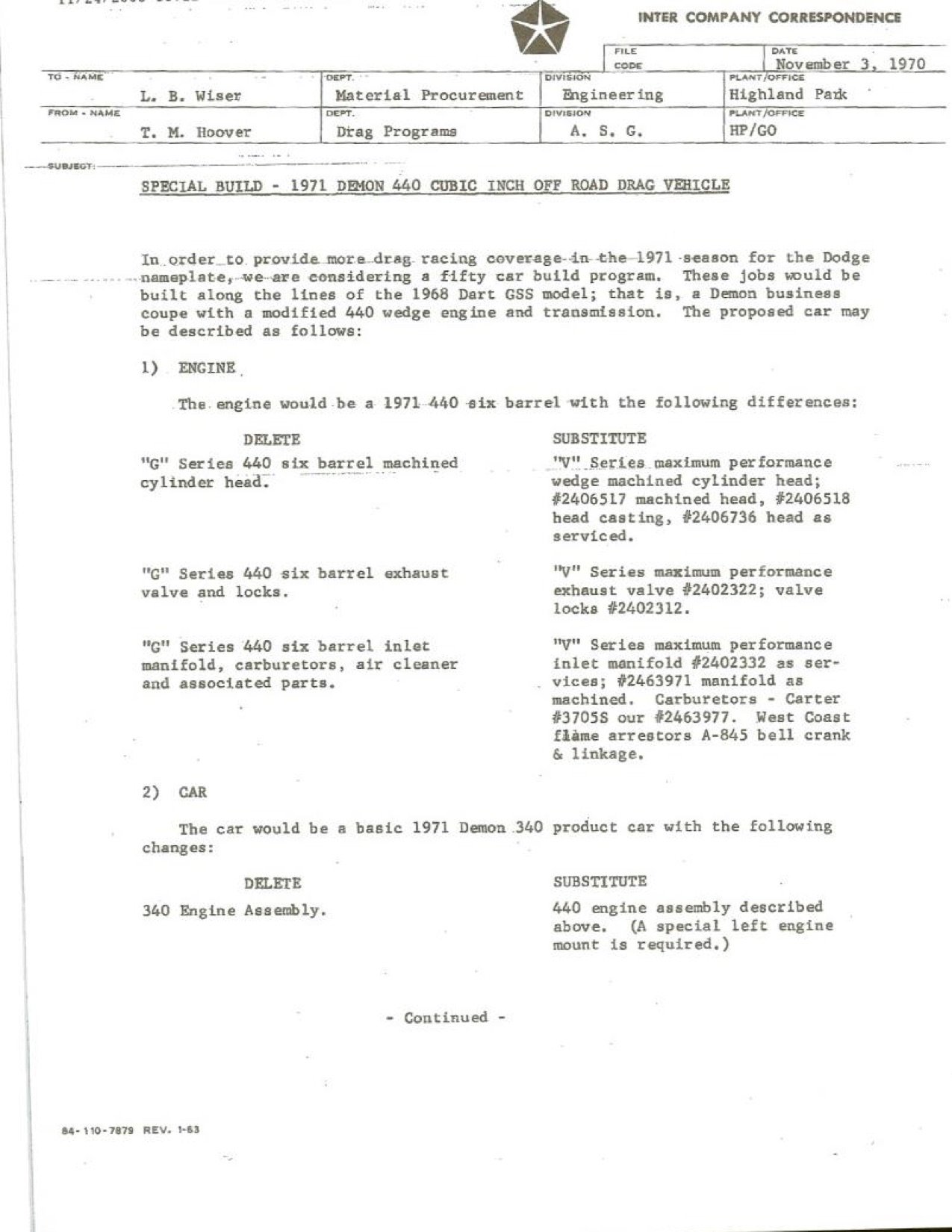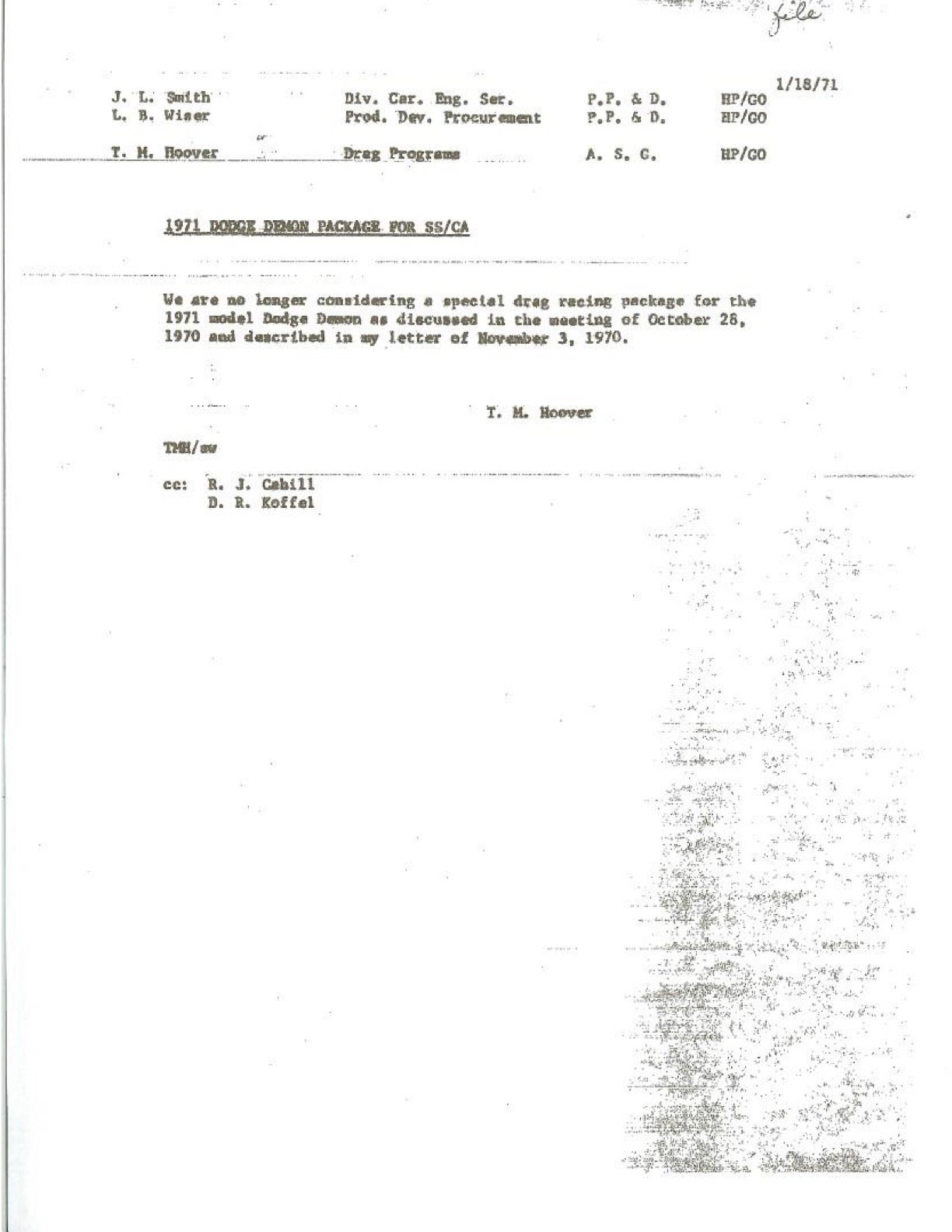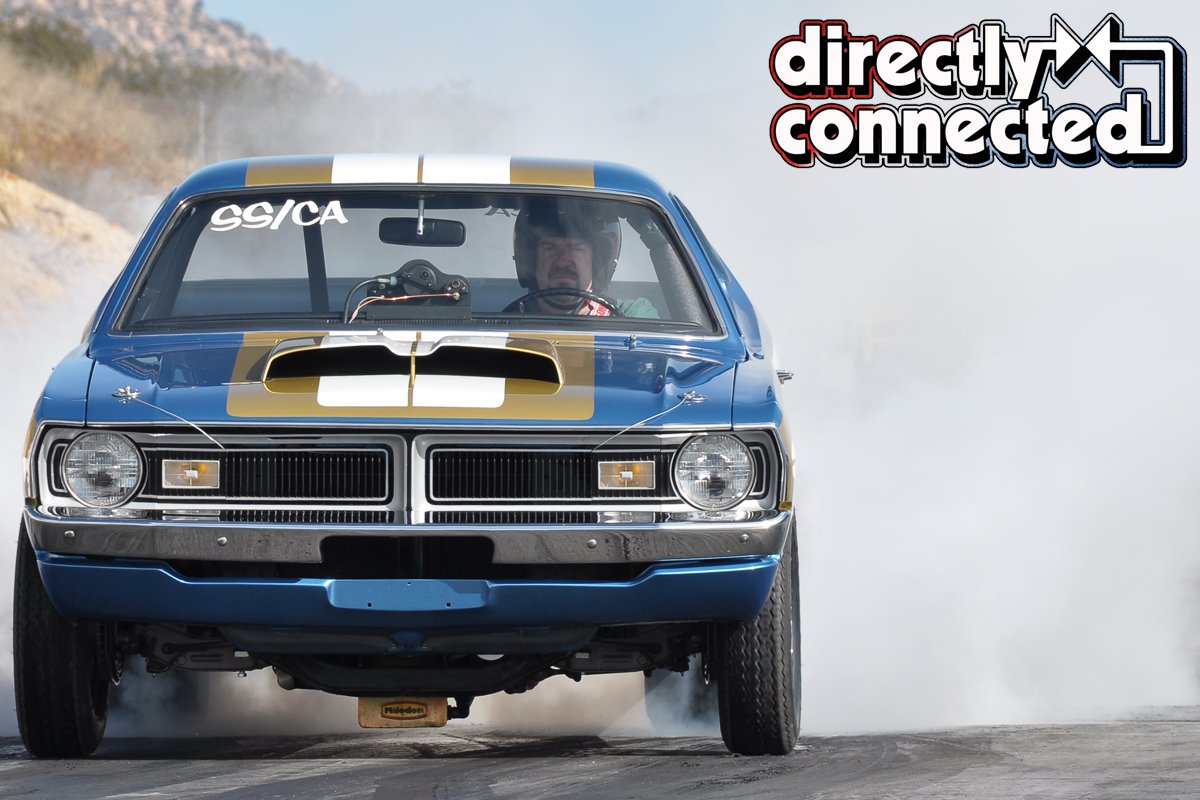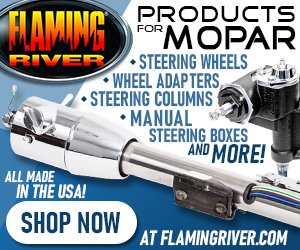In 2010, documents were unearthed in a long forgotten file cabinet at Mopar Performance that had not seen the light of day in over 40 years. The documents were prepared by Tom Hoover on October 6, 1970, who at that time was in the Drag Program Department at Chrysler. They contained information about a proposed vehicle program that would have had a significant impact on NHRA Super Stock racing. The result would have been even further domination by Dodge in this important segment.
First, a little history. The muscle car era was at its apex in 1970. Mirroring the enthusiasm for these vehicles, Super Stock racing was a hot bed of competition that fueled the passion of enthusiasts whose brand loyalty was at a fever pitch. During this time, Dodge enjoyed tremendous success in the fiercely contested NHRA Super Stock category with the highly feared 1968 Hemi Darts.
Above: 1971 440 cylinder block runs 12.5:1 compression pistons, a .590” lift Crane Cam is complemented by a mechanical valvetrain. Up top, NOS 1964 Max Wedge cylinder heads, factory cross ram intake and Carter AFB four barrels are just what Hoover spec’d, along with the carburetor flame arrestors.
By this time, it was obvious that the Hemi Dart Super Stock program had succeeded beyond the wildest expectations of Chrysler management, engineering and marketing. Between the Hemi Darts and the Hemi Cudas, these vehicles were nearly invincible in the SS/B and SS/BA classes, and were always serious contenders in Super Stock Eliminator competition.
The excitement generated by the Hemi Darts at tracks all over the country was driving (no pun intended) enthusiasts who were influenced by these nearly unbeatable door slammers into Dodge dealership showrooms. Regardless what vehicle or model they chose to purchase, the undeniable fact was that the old adage ‘race on Sunday and sell on Monday” was working very well for the Dodge Boys. Unlike Funny Cars or Top Fueler Dragsters, enthusiasts related to Super Stock, because these cars were mirror images of the vehicles they could purchase themselves. Enthusiasts love a winner, and Dodge had a real winner on its hands with the Hemi Dart.

Following in the footsteps of the Hemi Dart program, Tom Hoover realized that Dodge could utilize the same formula with the new Demon and dominate SS/C competition by building another limited production run of purpose built drag racing A-Bodies, this time powered by the 440 Six Pack engine equipped with the 1964 Max Wedge cylinder heads, dual four barrel cross ram manifold and Carter AFB carbs. Hoover rationalized that adding a Super Stock Demon to the racing arsenal would increase the chance of Dodge winning Super Stock Eliminator by 30 percent. Further, the success of the Demon program would influence enthusiasts, resulting in increased vehicle sales for Dodge.
Another bonus would be the re-release of the highly desirable 1964 Max Wedge cylinder heads that would result in additional sales for Mopar, partially offsetting the cost of the program, with the additional benefit of supporting racers who were running existing Dodges and Plymouths equipped with original heads that were in need of new replacement parts that currently did not exist. The Max Wedge heads would also provide 413, 426 and 440 RB engines with the proven combination they would need to effectively compete with Chevrolet and Ford “semi hemi” engines while further reinforcing Dodge’s performance image.
Above left: Dash is factory 340 Demon with auxiliary gauges. The Accutronic mechanical tach connects to a Direct Connection mechanical tach drive electronic distributor. Above center: four point roll cage was NHRA legal in 1971, but not today. Above right: Bostrum Dodge A100 van seats and Hurst floor shifter are from a 1968 Hemi Dart.
A base Demon was the foundation for the Super Stocker, and much like the Hemi Dart, the build order called for a wide range of off the shelf Mopar parts and accessories, many of which were readily available. For example, backing up the 440, the build called for the G Series Super Stock A727 Torqueflite in place of the regular 727, along with a special driveshaft equipped with heavy duty 7290 U-joints and axle flanges. Other components included a D-series 383 radiator, California flame arrestors for the dual Carter AFB four barrels and a ’64 Max Wedge style hood scoop. Inside, two lightweight Bostrum seats and brackets, a rear seat delete with a business coupe package shelf and rubber floor mat kept things simple (read light weight).
Legitimizing the business case for Chrysler, using the 1971 Demon as the foundation for this program would have generated tremendous enthusiast excitement for this new Dodge. The result would have been enhanced new vehicle and capture sales for the Demon, especially for the high performance 340 model that was poised to go toe to toe against the likes of small block Chevrolet Nova SS on the street and strip. And who’s to say that Mr. Norm at Grand Spaulding Dodge wouldn’t have reprised his 440 Dart GSS with a similar Demon for the street once the strip only race versions hit the asphalt, broke into the record books and created a tidal wave of interest in this high performance compact muscle car.

It looked like all systems go for the 440 Demon program, until it came to a screeching halt on January 18, 1971, when Tom Hoover notified everyone involved that it had been cancelled. While no formal reason was ever given for the project termination, it’s probably safe to say that it may have had something to do with the upcoming new federal emissions regulations that were demanding more and more engineering dollars and manpower.
When the plug was pulled on the 440 Demon Special Drag Racing Package, the paperwork was filed away and forgotten, making it little more than a footnote in history. David Hakim of Mopar Performance (now with HP2 Communications) found the documents and thought that this was a vehicle that should be brought to life just the way Hoover envisioned it. Hakim contacted several different likely candidates to build the Demon, but they either wanted to change the specs or had reservations about doing it.

When he contacted the Mr. Norm’s people, they had the interest, experience, talent and resources to get it done. Add to that the fact that Mr. Norm was the leading force behind the original 440 Dart and it was as good as a done deal. For the 50 production race only 440 Demons, Chrysler would have had them built by a subcontractor like Hurst-Campbell as they did with the Hemi Darts, but since that was water under the bridge, the chance to get at least one built was a huge step forward.
Jim Rhinehart, well known in the A-Body realm had access to an excellent Demon donor body in his collection of cars and parts, and the project was off and running. The body was put on a rotisserie and restored to better than new condition. While it was a solid piece, it was still in need of some sheet metal. AMD provided the quarters and floors, and the rest of the body panels were massaged to perfection. The paint job was based on an original artist’s rendering by Ben Hermance whose work was featured in The Designers Showcase in the May issue of Pentastar Power.
Above: The original rendering by Ben Hermance, who was featured in the May, 2014 issue of Pentastar Power is an excellent example of how the period correct graphics he designed for the 440 Demon Super Stock were replicated on the actual vehicle.
The graphics and logos Ben developed are reminiscent of the type that were very popular in the late ‘60’s and early 1970’s and translated perfectly with the build of the period perfect 1971 440 Demon Super Stock. The graphics are complemented by other era correct accessories, such as the Keystone wheels and an excellent rendition of the classic Mopar Max Wedge hood scoop that was designed to fit the Demon hood. Period accuracy carries through to the interior with the use of a genuine Hurst Shifter from an original Hemi Dart, a stock 340 Demon dashboard as specified by Hoover in the build, and a four point roll bar, which while correct for the era, would not pass muster with the NHRA today.
While not every element of the build was covered in the Hoover prepared documents, it would not have been a stretch to imagine racers using many of the same components that were used in the Hemi Darts. Exhaust would have been handled by fender well or under body headers, both of which were readily available, along with proven chassis mods that would have complied with the NHRA rules of the time. Other mods were similar in nature to those employed on the Hemi Darts and included spacing the K-Member down, which, in the case of the Demon was 5/8 inch. This alleviated the issue with hood clearance for the engine and header clearance underneath the vehicle.

The 440 engine was built by Greg Fernald, well known for the replica 1968 Hemi Darts and Hemi Cudas he builds at SSandAFX in Phoenix, Arizona. Built to the specs outlined by Tom Hoover, the engine started as a 1971 G-Code casting 440 Six Pack block, along with a Six Pack crank and rods, along with 12.5:1 TRW forged pistons. An extremely rare set of still in the box, new old stock 1964 Max Wedge heads were sourced from Scott Smith at Harms Automotive in Spokane, Washington. Bolted up the heads is an NOS cross ram intake manifold and the correct 9705 Carter AFB carbs, again box stock new. The solid lifter cam has a .590” lift, which definitely rocks the 440 just like back in the day and sounds just like what it is; a full on Super Stock race motor.
Crane adjustable rockers actuate the valve-train, and stock 440 painted valve covers hide the hardware. The reproduction throttle linkage and California Spark Arrestors that were spec’d by Hoover were provided by Jim Kramer at Kramer’s Automotive. An electric fuel pump acts as a pusher for the mechanical pump, while a fender mounted orange Mopar box provides the juice. The Torqueflite was also built by Fernald, and is the correct G Series 727. It’s equipped with a reverse manual valve body that’s actuated by the aforementioned Hemi Dart Hurst Shifter. Out back, an 8 ¾ rear end equipped with a 3.55:1 Sure Grip.

When the Demon was completed, it was shipped to Southern California where it had a date with destiny at the Barona Dragstrip in San Diego. The photos seen in this story were shot at the track, under a bright sunny sky. The track was rented just for the photo shoot, so we had plenty of time for lots of burnouts and action shots with the 440 Demon Super Stock. The Demon looked and sounded right at home in its natural environment, on the high traction asphalt. Jim Rhinehart handled the driving chores for the day, and did a great job.
The 440 made beautiful music through the uncorked JR Headers, and the Demon easily lit up the Mickey Thompson drag slicks for the burnout sessions, nearly obliterating the sun with smoke as he heated up the hides. While he could not make any full passes due to the fact that an ambulance was not present, the Demon made some very impressive launches, running to half tack when the tree flashed the green bulb. After watching the 440 Dart in action, we have no doubt that these cars would have been very successful in Super Stock competition.
Just imagine if Chrysler had built the 440 Demons and dominated SS/CA the way the Hemi Darts had ruled SS/BA. After a day at the track with the 440 Demon, we can honestly say that there’s a good likelihood that it would have happened. This 440 Demon may be the only one of its kind, but it is a real testament to what might have been.
Above: These are the original documents that Tom Hoover drafted outlining the 440 Demon Super Stock Program in October, 1970. The goal was for the 440 Demons to dominate SS/C just as the Hemi Darts were doing in SS/B. Not only would this have resulted in Chrysler dominance in the top Super Stock classes, it would also increase the chances of winning Super Stock Eliminator by 30 percent according to Hoover.
All images courtesy of The Brunt Bros. “Tom Hoover’s Super Stock 440 Demon Lives” was published in June, 2014 of Pentastar Power Magazine.





